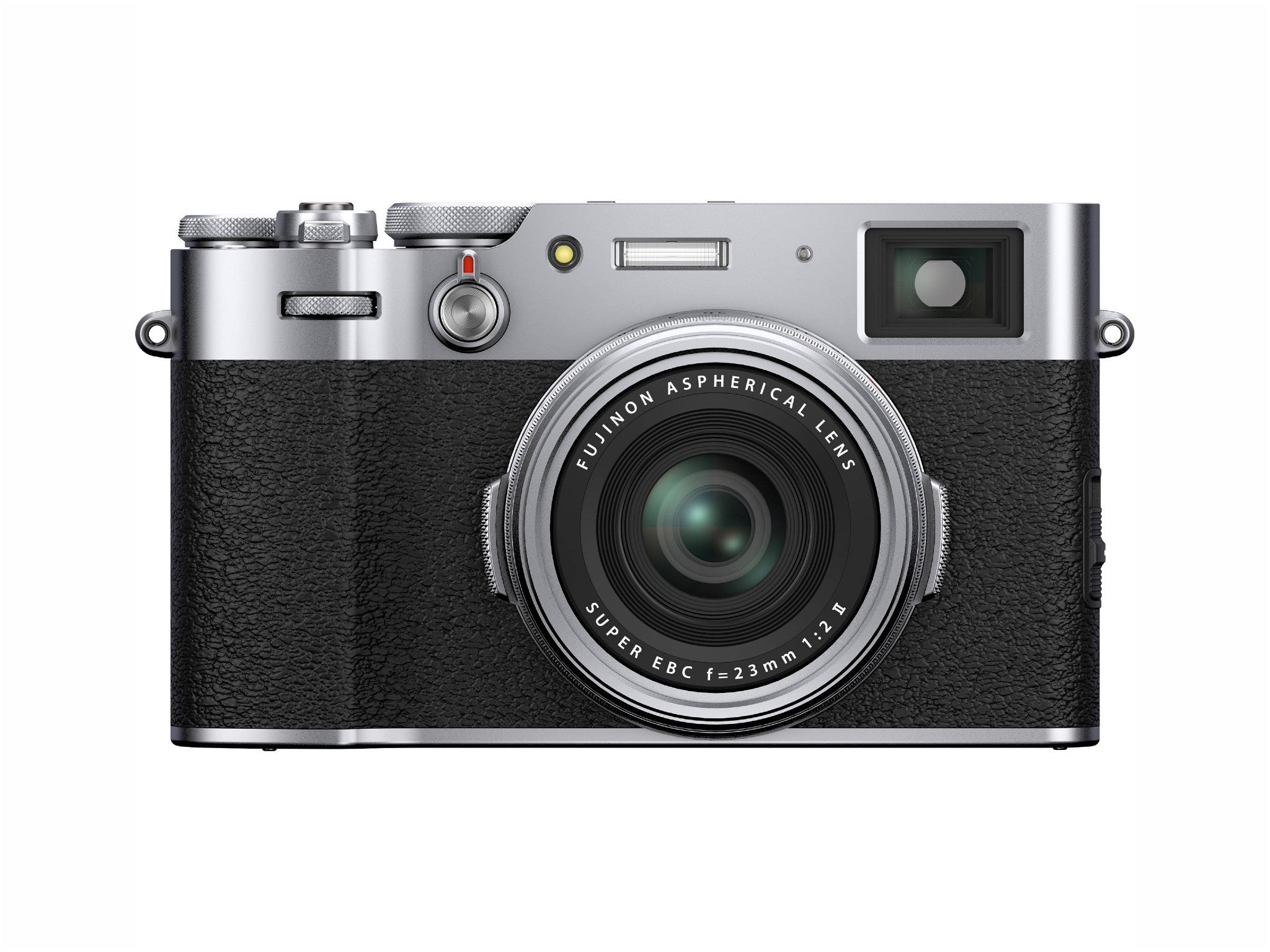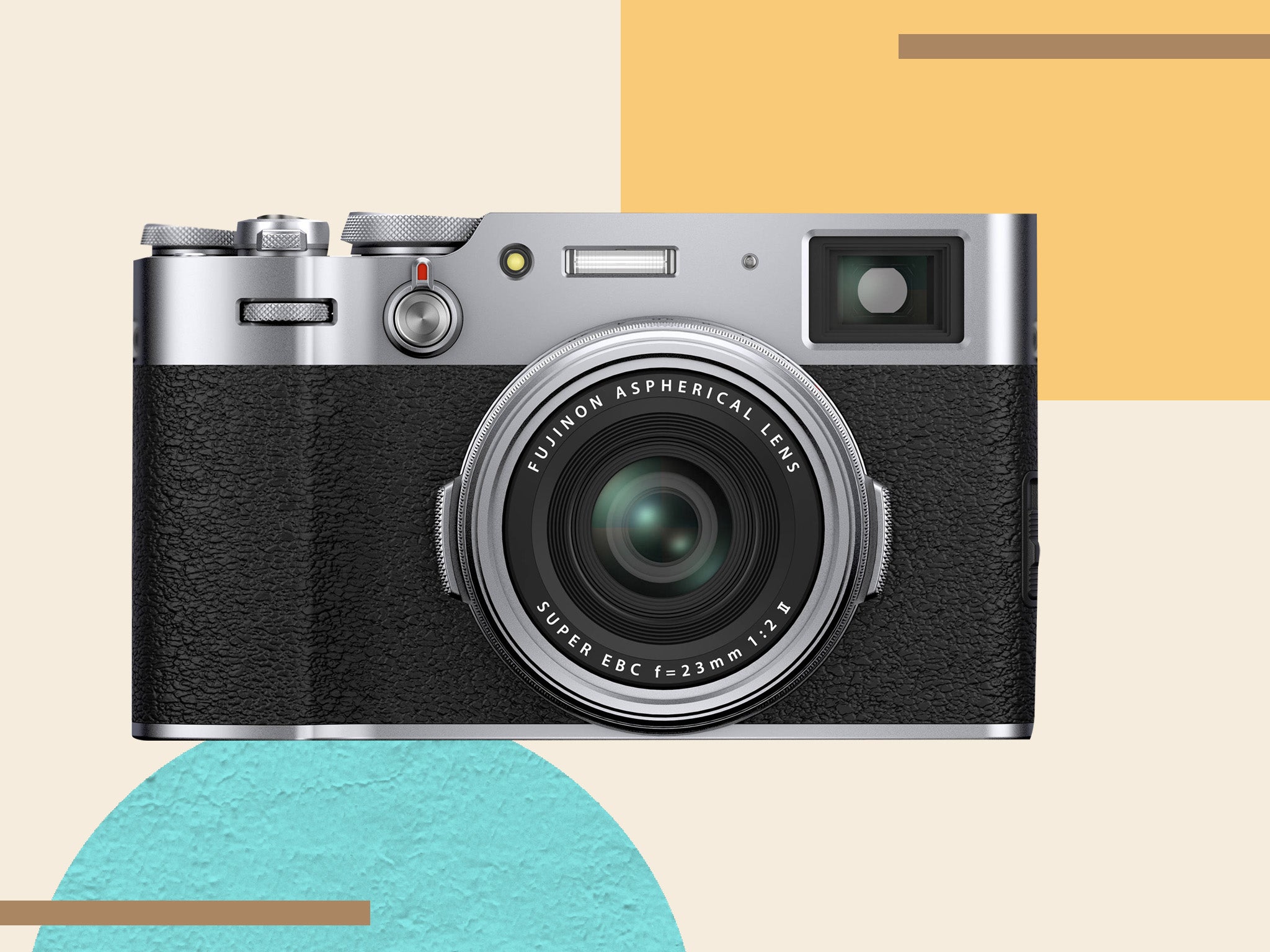Fujifilm X100V compact camera

Buy now £1,299, Johnlewis.com
- Megapixels: 26MP X-trans sensor
- Lens: 23mm F2 pancake
- Screen: Touchscreen LCD rear panel
- Video: 4K at 30fps
- Filter: 4-stop ND filter
- Rating: 9/10
First impressions
Out the box, you’re greeted with a pleasing retro design that will be familiar to Fujifilm aficionados and, in appearance, it looks much the same as previous X100 series incarnations. We liked the fact that it comes with a hybrid optical/digital viewfinder, which makes the camera feel more akin to compact setups of days gone by. The black and silver option is especially attractive and we liked the overall style and setup.
In the hand it feels small and compact but, due to the device’s entry-level SLR style large sensor, it doesn’t feel immediately geared towards the lightweight market. We had no trouble slipping it into our pocket for a day of use but if portability is your key buying criteria, you might want to have a look at your options first. A good camera bag circumvents this issue and also offers extra protection for the unit.
Speaking of protection, we liked the fact that Fujifilm has weather-proofed the camera – with dust and splash protection – which is an excellent feature that will appeal to documentary and travel photographers out in the wild. It’s a little bit of a shame that you have to buy an extra filter to offer the same protection for the lens, but the AR-X100 adapter is available for about £40 extra. Third-party parts are also available.
Lens and picture quality
The 23mm lens offers a semi-wide angle but you can buy add-ons that provide both 28mm and 50mm optics. They’re available separately and cost about £300 – so not cheap – but it does widen the appeal of the device to a range of types of photographers. It’s nice and fast at F2 and, although it’s driven by new software and has been totally redesigned, it feels very familiar to previous examples of the X100. Fujifilm does offer a range of small cameras that have interchangeable lenses but if you’re after a compact setup that saves the hassle, we think this is the next best thing.
Read more: 6 best drones for beginners: Take to the sky with these entry-level models
Photo quality is good, with central focus and excellent correction at the edges of the frame that saves distortion. The ND filter works to four stops, making it really useful for getting an even light in landscape shots in particular. We particularly liked how sharp the images looked when near to the camera – the lens will focus to just under 4in and it displays a quality significantly better than previous versions. In general, there’s a crisp, dynamic and clear approach to the images it creates without too much smoothing and with the generous sensor size it does feel very much like a premium product.
Features
Face and eye detection in images comes as standard, as well as a series of features that make JPGs editable on the device itself, with software that does an excellent job of colour enhancement, noise reduction and detail accentuation. There are also a number of film simulations that add grain, noise and general imperfections we’re more used to seeing on old 35mm film cameras. The tilting touchscreen works really well – it’s decisive and responds very well to inputs in terms of both autofocus and setting menu items. Body controls, ergonomics and handling is impressive and has a very old-fashioned feel – the dial at the top, for example, has satisfying indents and feels much like cameras from a bygone era – not that in this case that’s a bad thing.
If you’re into video, you won’t be disappointed either. The camera offers 4K at 30fps and, although the device isn’t really setup as a filmmaker’s unit, the output is excellent, crisp and sharp. Although the autofocus works really well, there’s no image stabilisation, so footage can appear quite shaky. If you’re really into movies, it might be worth casting your eye elsewhere.
The verdict: Fujifilm X100V compact camera
Overall, we were really impressed with the Fujifilm X100V. It’s the best X100 yet by a long shot and the general usability and image quality is up there with some far more expensive cameras. That being said, we do also think that some of its appeal comes with its retro styling and general look and feel – it’s a sturdy design, uses classic, timeless features that work well and it feels like a premium, well-thought-out piece of modern technology in an ageless body.
The images have a crisp, vibrant quality to them with a warm colour reproduction that echoes old 35mm cameras of days gone by like the Olympus Trip but with the clarity and sharpness of modern digital technology. Delving into the numerous editing options available within the camera itself, some very pleasing retro-inspired looks can be achieved, with decent colour grading variables and grain presets that give the images a timeless quality, ready to be shared on social media or to other devices using the wireless and Bluetooth connectivity.
There is no getting away from the fact, however, that it’s an expensive setup. There are deals available but it tends to sit a shade over £1,200, which is a lot of money for a compact camera when SLR and bridge camera deals are often much cheaper. The only other camera like this though is the Leica Q2 (£4,500, Wexphotovideo.com), which really does tend to the luxury market only and does therefore make this seem like a very good option indeed.

